APC308 Financial Management: Investment Appraisal Techniques Report
VerifiedAdded on 2023/06/12
|14
|3966
|279
Report
AI Summary
This report provides an overview of financial management, focusing on investment appraisal techniques such as Net Present Value (NPV), Internal Rate of Return (IRR), payback period, and discounted cash flow methods. It evaluates these methods in the context of project attractiveness and profitability, including calculations and recommendations for Kings PLC. The report also discusses the benefits and drawbacks of each technique, offering insights into their practical applications and limitations in financial decision-making. Additionally, the report touches on the effects of financial proposals on firms, such as share repurchases and dividend distribution.

FINANCIAL
MANAGEMENT
MANAGEMENT
Paraphrase This Document
Need a fresh take? Get an instant paraphrase of this document with our AI Paraphraser
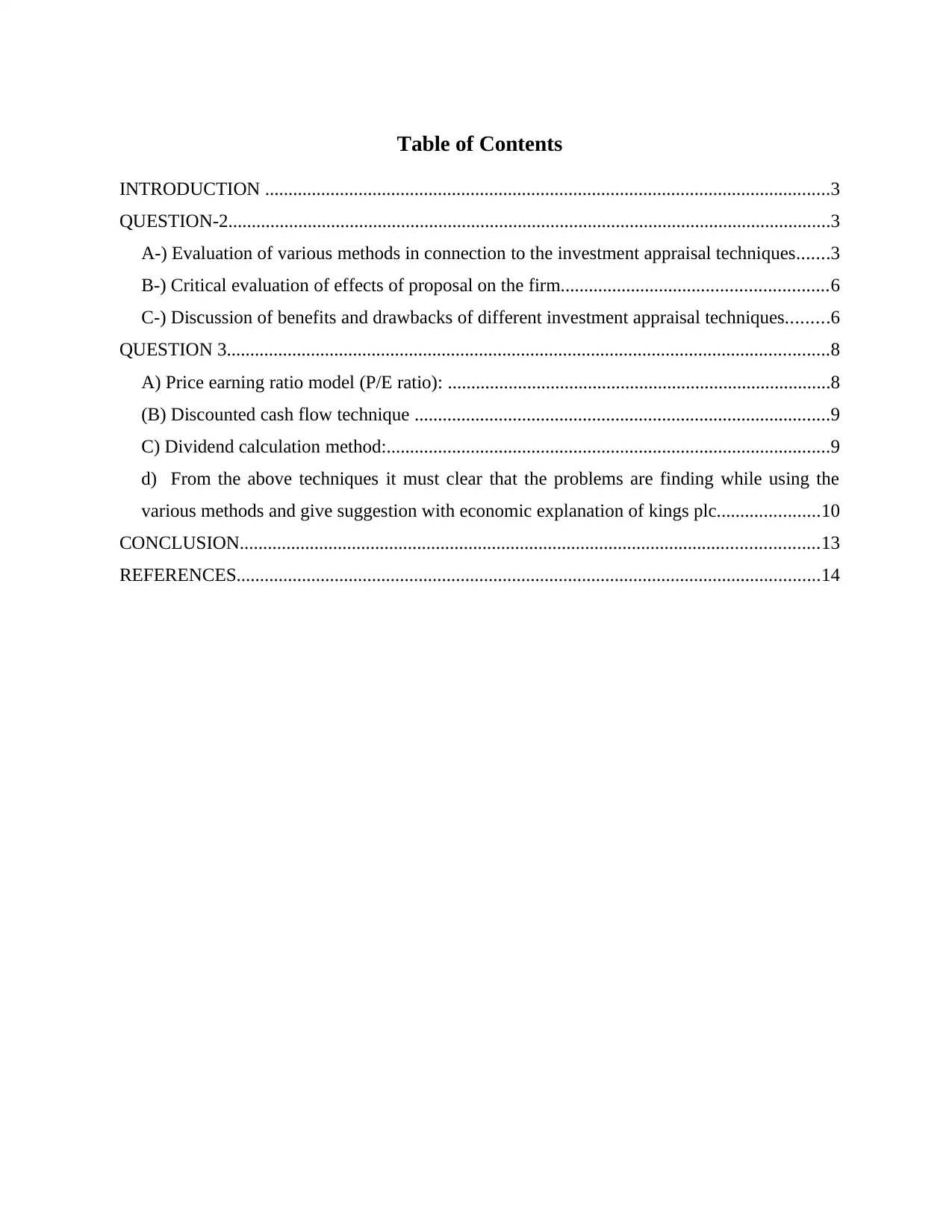
Table of Contents
INTRODUCTION .........................................................................................................................3
QUESTION-2.................................................................................................................................3
A-) Evaluation of various methods in connection to the investment appraisal techniques.......3
B-) Critical evaluation of effects of proposal on the firm.........................................................6
C-) Discussion of benefits and drawbacks of different investment appraisal techniques.........6
QUESTION 3.................................................................................................................................8
A) Price earning ratio model (P/E ratio): ..................................................................................8
(B) Discounted cash flow technique .........................................................................................9
C) Dividend calculation method:...............................................................................................9
d) From the above techniques it must clear that the problems are finding while using the
various methods and give suggestion with economic explanation of kings plc......................10
CONCLUSION............................................................................................................................13
REFERENCES.............................................................................................................................14
INTRODUCTION .........................................................................................................................3
QUESTION-2.................................................................................................................................3
A-) Evaluation of various methods in connection to the investment appraisal techniques.......3
B-) Critical evaluation of effects of proposal on the firm.........................................................6
C-) Discussion of benefits and drawbacks of different investment appraisal techniques.........6
QUESTION 3.................................................................................................................................8
A) Price earning ratio model (P/E ratio): ..................................................................................8
(B) Discounted cash flow technique .........................................................................................9
C) Dividend calculation method:...............................................................................................9
d) From the above techniques it must clear that the problems are finding while using the
various methods and give suggestion with economic explanation of kings plc......................10
CONCLUSION............................................................................................................................13
REFERENCES.............................................................................................................................14
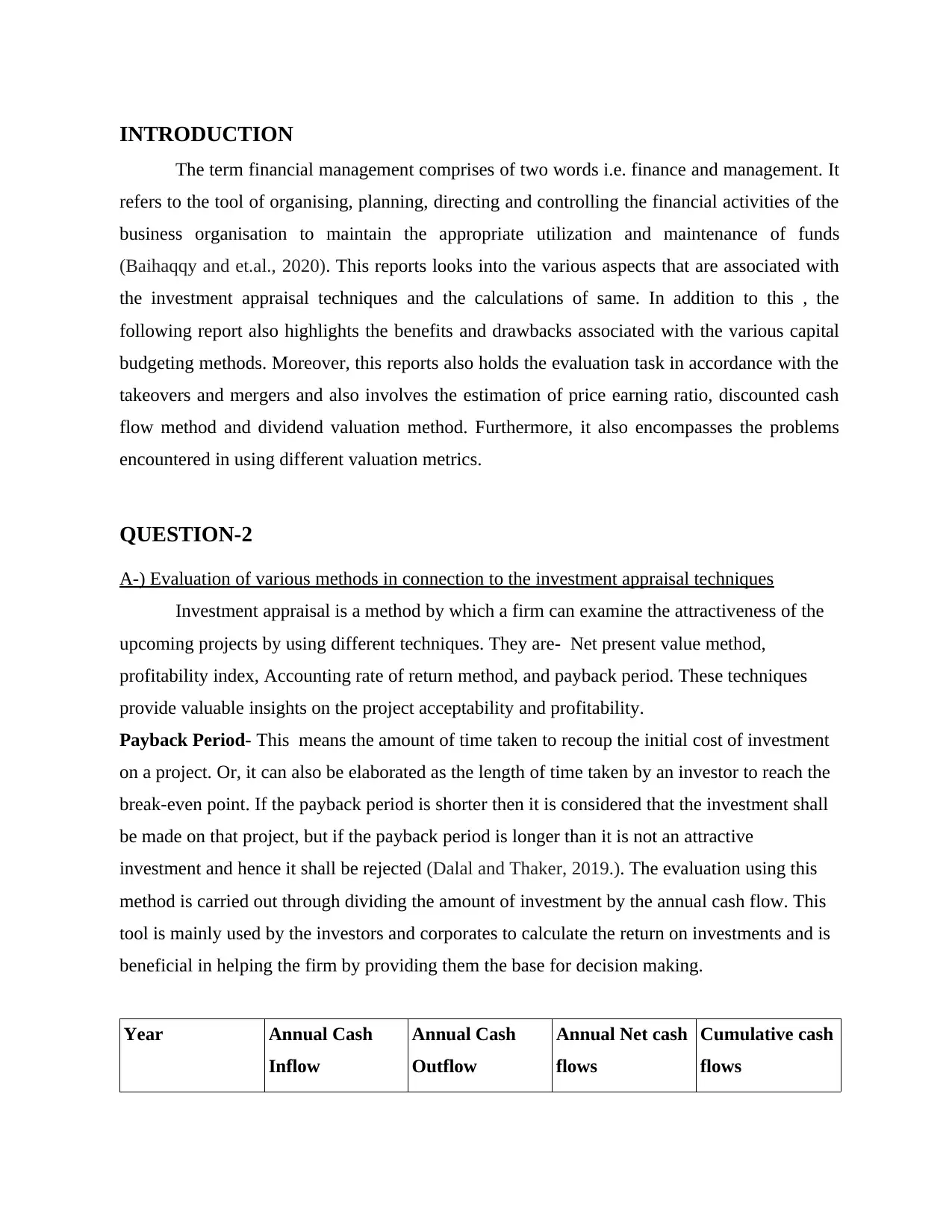
INTRODUCTION
The term financial management comprises of two words i.e. finance and management. It
refers to the tool of organising, planning, directing and controlling the financial activities of the
business organisation to maintain the appropriate utilization and maintenance of funds
(Baihaqqy and et.al., 2020). This reports looks into the various aspects that are associated with
the investment appraisal techniques and the calculations of same. In addition to this , the
following report also highlights the benefits and drawbacks associated with the various capital
budgeting methods. Moreover, this reports also holds the evaluation task in accordance with the
takeovers and mergers and also involves the estimation of price earning ratio, discounted cash
flow method and dividend valuation method. Furthermore, it also encompasses the problems
encountered in using different valuation metrics.
QUESTION-2
A-) Evaluation of various methods in connection to the investment appraisal techniques
Investment appraisal is a method by which a firm can examine the attractiveness of the
upcoming projects by using different techniques. They are- Net present value method,
profitability index, Accounting rate of return method, and payback period. These techniques
provide valuable insights on the project acceptability and profitability.
Payback Period- This means the amount of time taken to recoup the initial cost of investment
on a project. Or, it can also be elaborated as the length of time taken by an investor to reach the
break-even point. If the payback period is shorter then it is considered that the investment shall
be made on that project, but if the payback period is longer than it is not an attractive
investment and hence it shall be rejected (Dalal and Thaker, 2019.). The evaluation using this
method is carried out through dividing the amount of investment by the annual cash flow. This
tool is mainly used by the investors and corporates to calculate the return on investments and is
beneficial in helping the firm by providing them the base for decision making.
Year Annual Cash
Inflow
Annual Cash
Outflow
Annual Net cash
flows
Cumulative cash
flows
The term financial management comprises of two words i.e. finance and management. It
refers to the tool of organising, planning, directing and controlling the financial activities of the
business organisation to maintain the appropriate utilization and maintenance of funds
(Baihaqqy and et.al., 2020). This reports looks into the various aspects that are associated with
the investment appraisal techniques and the calculations of same. In addition to this , the
following report also highlights the benefits and drawbacks associated with the various capital
budgeting methods. Moreover, this reports also holds the evaluation task in accordance with the
takeovers and mergers and also involves the estimation of price earning ratio, discounted cash
flow method and dividend valuation method. Furthermore, it also encompasses the problems
encountered in using different valuation metrics.
QUESTION-2
A-) Evaluation of various methods in connection to the investment appraisal techniques
Investment appraisal is a method by which a firm can examine the attractiveness of the
upcoming projects by using different techniques. They are- Net present value method,
profitability index, Accounting rate of return method, and payback period. These techniques
provide valuable insights on the project acceptability and profitability.
Payback Period- This means the amount of time taken to recoup the initial cost of investment
on a project. Or, it can also be elaborated as the length of time taken by an investor to reach the
break-even point. If the payback period is shorter then it is considered that the investment shall
be made on that project, but if the payback period is longer than it is not an attractive
investment and hence it shall be rejected (Dalal and Thaker, 2019.). The evaluation using this
method is carried out through dividing the amount of investment by the annual cash flow. This
tool is mainly used by the investors and corporates to calculate the return on investments and is
beneficial in helping the firm by providing them the base for decision making.
Year Annual Cash
Inflow
Annual Cash
Outflow
Annual Net cash
flows
Cumulative cash
flows
⊘ This is a preview!⊘
Do you want full access?
Subscribe today to unlock all pages.

Trusted by 1+ million students worldwide
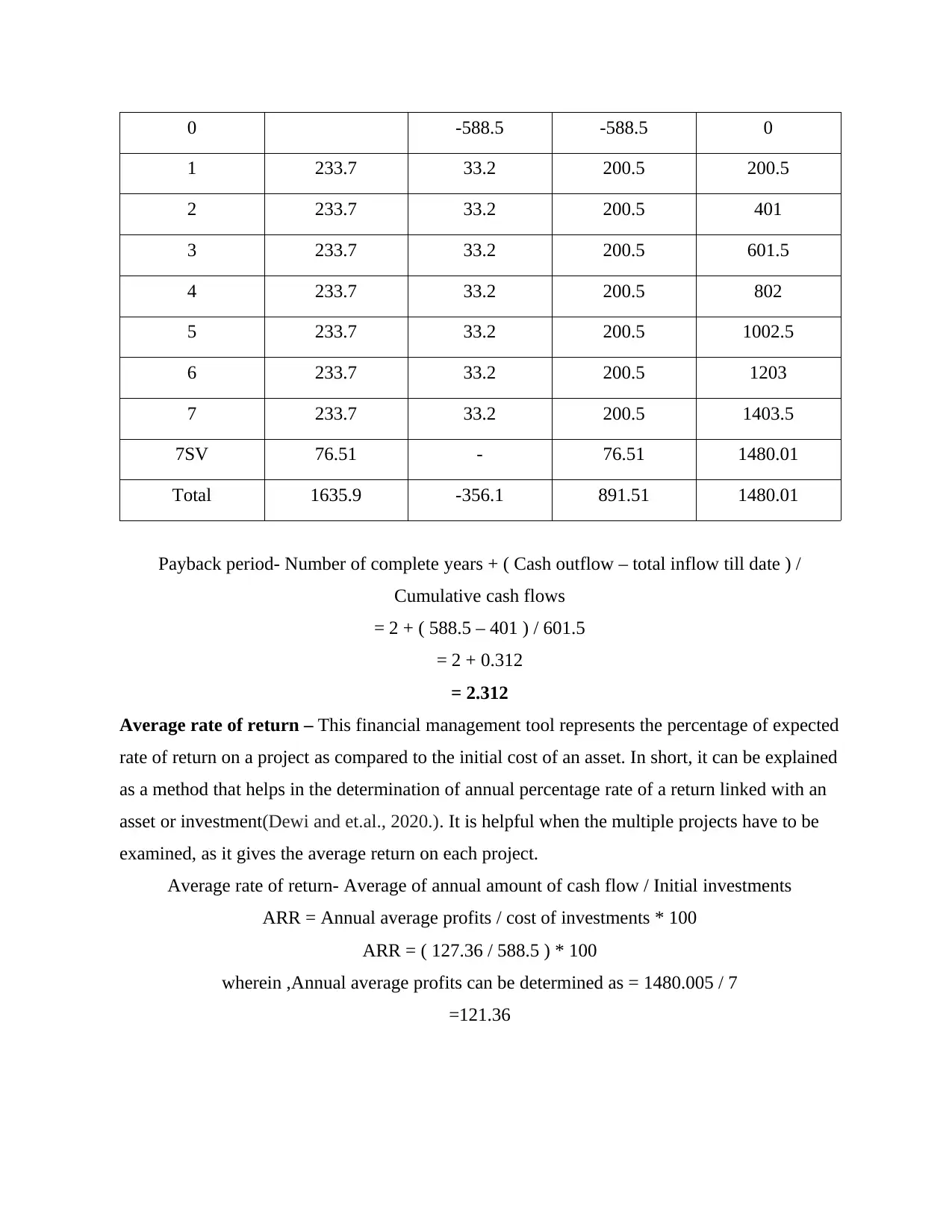
0 -588.5 -588.5 0
1 233.7 33.2 200.5 200.5
2 233.7 33.2 200.5 401
3 233.7 33.2 200.5 601.5
4 233.7 33.2 200.5 802
5 233.7 33.2 200.5 1002.5
6 233.7 33.2 200.5 1203
7 233.7 33.2 200.5 1403.5
7SV 76.51 - 76.51 1480.01
Total 1635.9 -356.1 891.51 1480.01
Payback period- Number of complete years + ( Cash outflow – total inflow till date ) /
Cumulative cash flows
= 2 + ( 588.5 – 401 ) / 601.5
= 2 + 0.312
= 2.312
Average rate of return – This financial management tool represents the percentage of expected
rate of return on a project as compared to the initial cost of an asset. In short, it can be explained
as a method that helps in the determination of annual percentage rate of a return linked with an
asset or investment(Dewi and et.al., 2020.). It is helpful when the multiple projects have to be
examined, as it gives the average return on each project.
Average rate of return- Average of annual amount of cash flow / Initial investments
ARR = Annual average profits / cost of investments * 100
ARR = ( 127.36 / 588.5 ) * 100
wherein ,Annual average profits can be determined as = 1480.005 / 7
=121.36
1 233.7 33.2 200.5 200.5
2 233.7 33.2 200.5 401
3 233.7 33.2 200.5 601.5
4 233.7 33.2 200.5 802
5 233.7 33.2 200.5 1002.5
6 233.7 33.2 200.5 1203
7 233.7 33.2 200.5 1403.5
7SV 76.51 - 76.51 1480.01
Total 1635.9 -356.1 891.51 1480.01
Payback period- Number of complete years + ( Cash outflow – total inflow till date ) /
Cumulative cash flows
= 2 + ( 588.5 – 401 ) / 601.5
= 2 + 0.312
= 2.312
Average rate of return – This financial management tool represents the percentage of expected
rate of return on a project as compared to the initial cost of an asset. In short, it can be explained
as a method that helps in the determination of annual percentage rate of a return linked with an
asset or investment(Dewi and et.al., 2020.). It is helpful when the multiple projects have to be
examined, as it gives the average return on each project.
Average rate of return- Average of annual amount of cash flow / Initial investments
ARR = Annual average profits / cost of investments * 100
ARR = ( 127.36 / 588.5 ) * 100
wherein ,Annual average profits can be determined as = 1480.005 / 7
=121.36
Paraphrase This Document
Need a fresh take? Get an instant paraphrase of this document with our AI Paraphraser
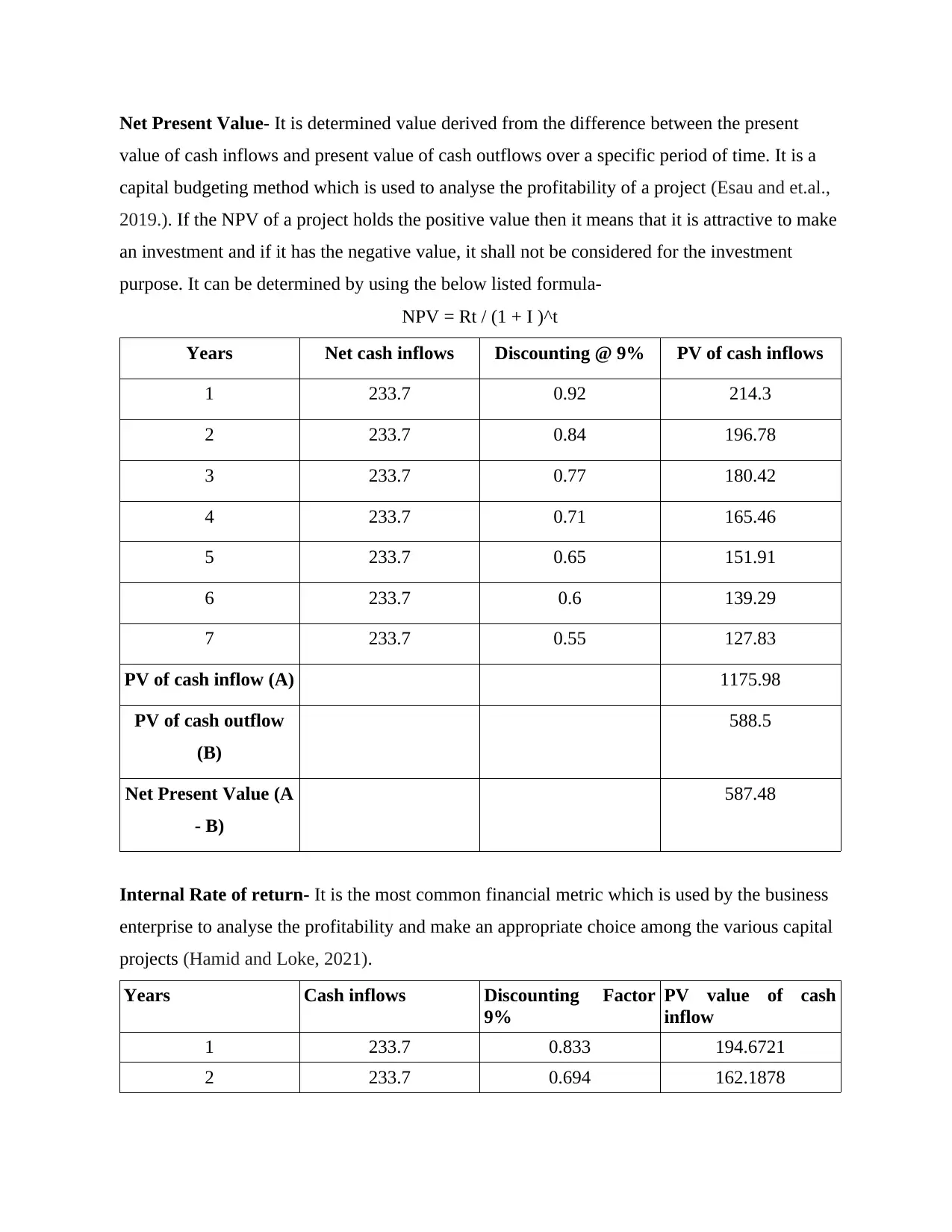
Net Present Value- It is determined value derived from the difference between the present
value of cash inflows and present value of cash outflows over a specific period of time. It is a
capital budgeting method which is used to analyse the profitability of a project (Esau and et.al.,
2019.). If the NPV of a project holds the positive value then it means that it is attractive to make
an investment and if it has the negative value, it shall not be considered for the investment
purpose. It can be determined by using the below listed formula-
NPV = Rt / (1 + I )^t
Years Net cash inflows Discounting @ 9% PV of cash inflows
1 233.7 0.92 214.3
2 233.7 0.84 196.78
3 233.7 0.77 180.42
4 233.7 0.71 165.46
5 233.7 0.65 151.91
6 233.7 0.6 139.29
7 233.7 0.55 127.83
PV of cash inflow (A) 1175.98
PV of cash outflow
(B)
588.5
Net Present Value (A
- B)
587.48
Internal Rate of return- It is the most common financial metric which is used by the business
enterprise to analyse the profitability and make an appropriate choice among the various capital
projects (Hamid and Loke, 2021).
Years Cash inflows Discounting Factor
9%
PV value of cash
inflow
1 233.7 0.833 194.6721
2 233.7 0.694 162.1878
value of cash inflows and present value of cash outflows over a specific period of time. It is a
capital budgeting method which is used to analyse the profitability of a project (Esau and et.al.,
2019.). If the NPV of a project holds the positive value then it means that it is attractive to make
an investment and if it has the negative value, it shall not be considered for the investment
purpose. It can be determined by using the below listed formula-
NPV = Rt / (1 + I )^t
Years Net cash inflows Discounting @ 9% PV of cash inflows
1 233.7 0.92 214.3
2 233.7 0.84 196.78
3 233.7 0.77 180.42
4 233.7 0.71 165.46
5 233.7 0.65 151.91
6 233.7 0.6 139.29
7 233.7 0.55 127.83
PV of cash inflow (A) 1175.98
PV of cash outflow
(B)
588.5
Net Present Value (A
- B)
587.48
Internal Rate of return- It is the most common financial metric which is used by the business
enterprise to analyse the profitability and make an appropriate choice among the various capital
projects (Hamid and Loke, 2021).
Years Cash inflows Discounting Factor
9%
PV value of cash
inflow
1 233.7 0.833 194.6721
2 233.7 0.694 162.1878
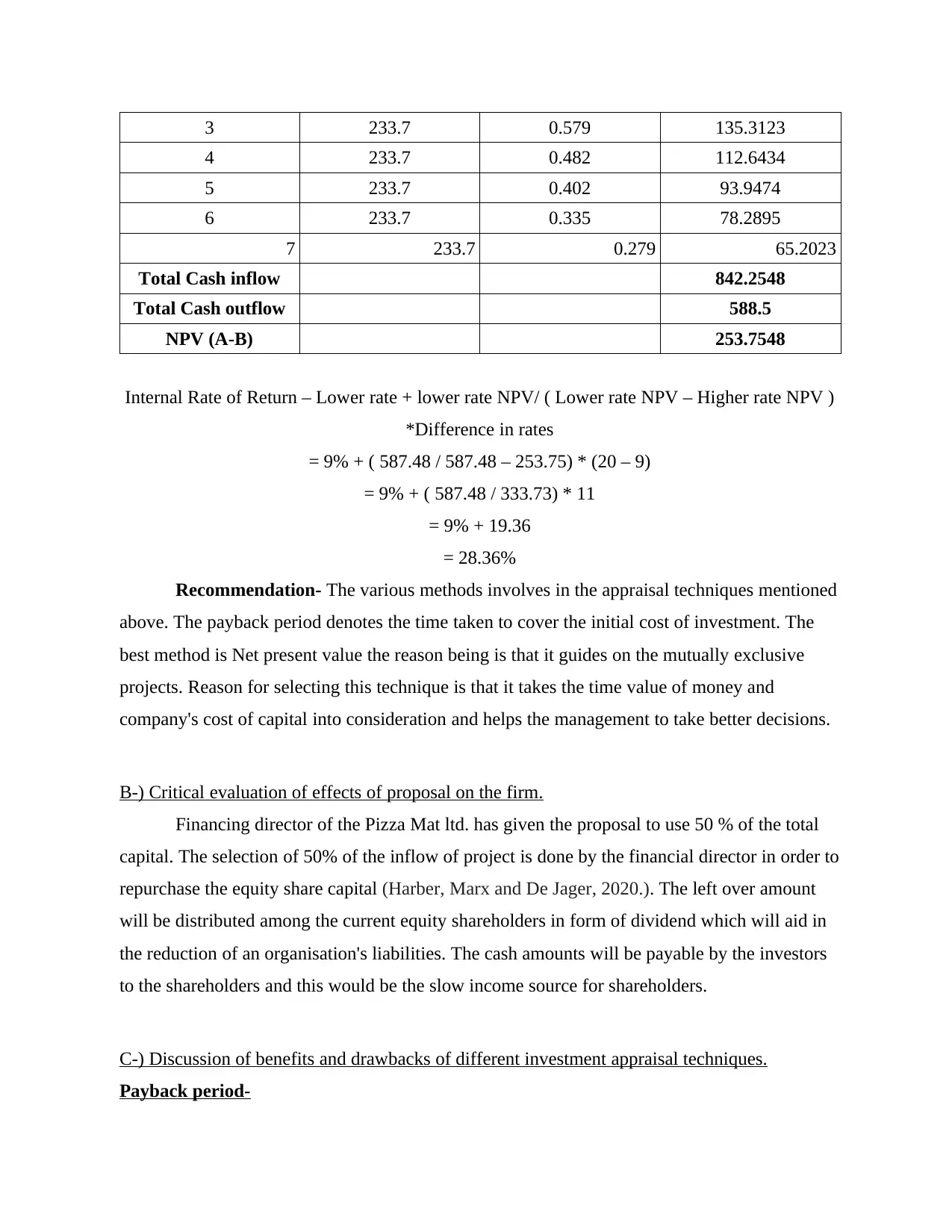
3 233.7 0.579 135.3123
4 233.7 0.482 112.6434
5 233.7 0.402 93.9474
6 233.7 0.335 78.2895
7 233.7 0.279 65.2023
Total Cash inflow 842.2548
Total Cash outflow 588.5
NPV (A-B) 253.7548
Internal Rate of Return – Lower rate + lower rate NPV/ ( Lower rate NPV – Higher rate NPV )
*Difference in rates
= 9% + ( 587.48 / 587.48 – 253.75) * (20 – 9)
= 9% + ( 587.48 / 333.73) * 11
= 9% + 19.36
= 28.36%
Recommendation- The various methods involves in the appraisal techniques mentioned
above. The payback period denotes the time taken to cover the initial cost of investment. The
best method is Net present value the reason being is that it guides on the mutually exclusive
projects. Reason for selecting this technique is that it takes the time value of money and
company's cost of capital into consideration and helps the management to take better decisions.
B-) Critical evaluation of effects of proposal on the firm.
Financing director of the Pizza Mat ltd. has given the proposal to use 50 % of the total
capital. The selection of 50% of the inflow of project is done by the financial director in order to
repurchase the equity share capital (Harber, Marx and De Jager, 2020.). The left over amount
will be distributed among the current equity shareholders in form of dividend which will aid in
the reduction of an organisation's liabilities. The cash amounts will be payable by the investors
to the shareholders and this would be the slow income source for shareholders.
C-) Discussion of benefits and drawbacks of different investment appraisal techniques.
Payback period-
4 233.7 0.482 112.6434
5 233.7 0.402 93.9474
6 233.7 0.335 78.2895
7 233.7 0.279 65.2023
Total Cash inflow 842.2548
Total Cash outflow 588.5
NPV (A-B) 253.7548
Internal Rate of Return – Lower rate + lower rate NPV/ ( Lower rate NPV – Higher rate NPV )
*Difference in rates
= 9% + ( 587.48 / 587.48 – 253.75) * (20 – 9)
= 9% + ( 587.48 / 333.73) * 11
= 9% + 19.36
= 28.36%
Recommendation- The various methods involves in the appraisal techniques mentioned
above. The payback period denotes the time taken to cover the initial cost of investment. The
best method is Net present value the reason being is that it guides on the mutually exclusive
projects. Reason for selecting this technique is that it takes the time value of money and
company's cost of capital into consideration and helps the management to take better decisions.
B-) Critical evaluation of effects of proposal on the firm.
Financing director of the Pizza Mat ltd. has given the proposal to use 50 % of the total
capital. The selection of 50% of the inflow of project is done by the financial director in order to
repurchase the equity share capital (Harber, Marx and De Jager, 2020.). The left over amount
will be distributed among the current equity shareholders in form of dividend which will aid in
the reduction of an organisation's liabilities. The cash amounts will be payable by the investors
to the shareholders and this would be the slow income source for shareholders.
C-) Discussion of benefits and drawbacks of different investment appraisal techniques.
Payback period-
⊘ This is a preview!⊘
Do you want full access?
Subscribe today to unlock all pages.

Trusted by 1+ million students worldwide
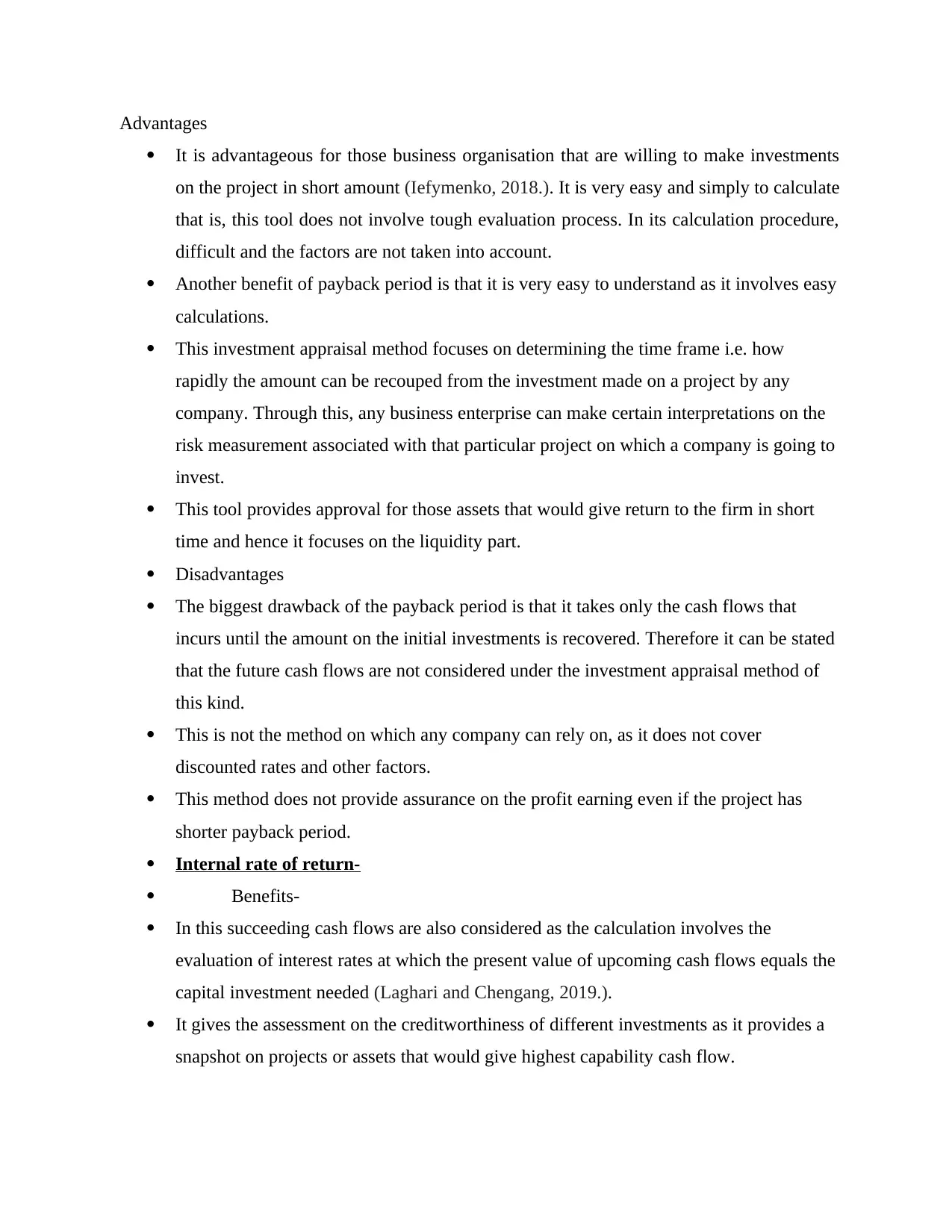
Advantages
It is advantageous for those business organisation that are willing to make investments
on the project in short amount (Iefymenko, 2018.). It is very easy and simply to calculate
that is, this tool does not involve tough evaluation process. In its calculation procedure,
difficult and the factors are not taken into account.
Another benefit of payback period is that it is very easy to understand as it involves easy
calculations.
This investment appraisal method focuses on determining the time frame i.e. how
rapidly the amount can be recouped from the investment made on a project by any
company. Through this, any business enterprise can make certain interpretations on the
risk measurement associated with that particular project on which a company is going to
invest.
This tool provides approval for those assets that would give return to the firm in short
time and hence it focuses on the liquidity part.
Disadvantages
The biggest drawback of the payback period is that it takes only the cash flows that
incurs until the amount on the initial investments is recovered. Therefore it can be stated
that the future cash flows are not considered under the investment appraisal method of
this kind.
This is not the method on which any company can rely on, as it does not cover
discounted rates and other factors.
This method does not provide assurance on the profit earning even if the project has
shorter payback period.
Internal rate of return-
Benefits-
In this succeeding cash flows are also considered as the calculation involves the
evaluation of interest rates at which the present value of upcoming cash flows equals the
capital investment needed (Laghari and Chengang, 2019.).
It gives the assessment on the creditworthiness of different investments as it provides a
snapshot on projects or assets that would give highest capability cash flow.
It is advantageous for those business organisation that are willing to make investments
on the project in short amount (Iefymenko, 2018.). It is very easy and simply to calculate
that is, this tool does not involve tough evaluation process. In its calculation procedure,
difficult and the factors are not taken into account.
Another benefit of payback period is that it is very easy to understand as it involves easy
calculations.
This investment appraisal method focuses on determining the time frame i.e. how
rapidly the amount can be recouped from the investment made on a project by any
company. Through this, any business enterprise can make certain interpretations on the
risk measurement associated with that particular project on which a company is going to
invest.
This tool provides approval for those assets that would give return to the firm in short
time and hence it focuses on the liquidity part.
Disadvantages
The biggest drawback of the payback period is that it takes only the cash flows that
incurs until the amount on the initial investments is recovered. Therefore it can be stated
that the future cash flows are not considered under the investment appraisal method of
this kind.
This is not the method on which any company can rely on, as it does not cover
discounted rates and other factors.
This method does not provide assurance on the profit earning even if the project has
shorter payback period.
Internal rate of return-
Benefits-
In this succeeding cash flows are also considered as the calculation involves the
evaluation of interest rates at which the present value of upcoming cash flows equals the
capital investment needed (Laghari and Chengang, 2019.).
It gives the assessment on the creditworthiness of different investments as it provides a
snapshot on projects or assets that would give highest capability cash flow.
Paraphrase This Document
Need a fresh take? Get an instant paraphrase of this document with our AI Paraphraser
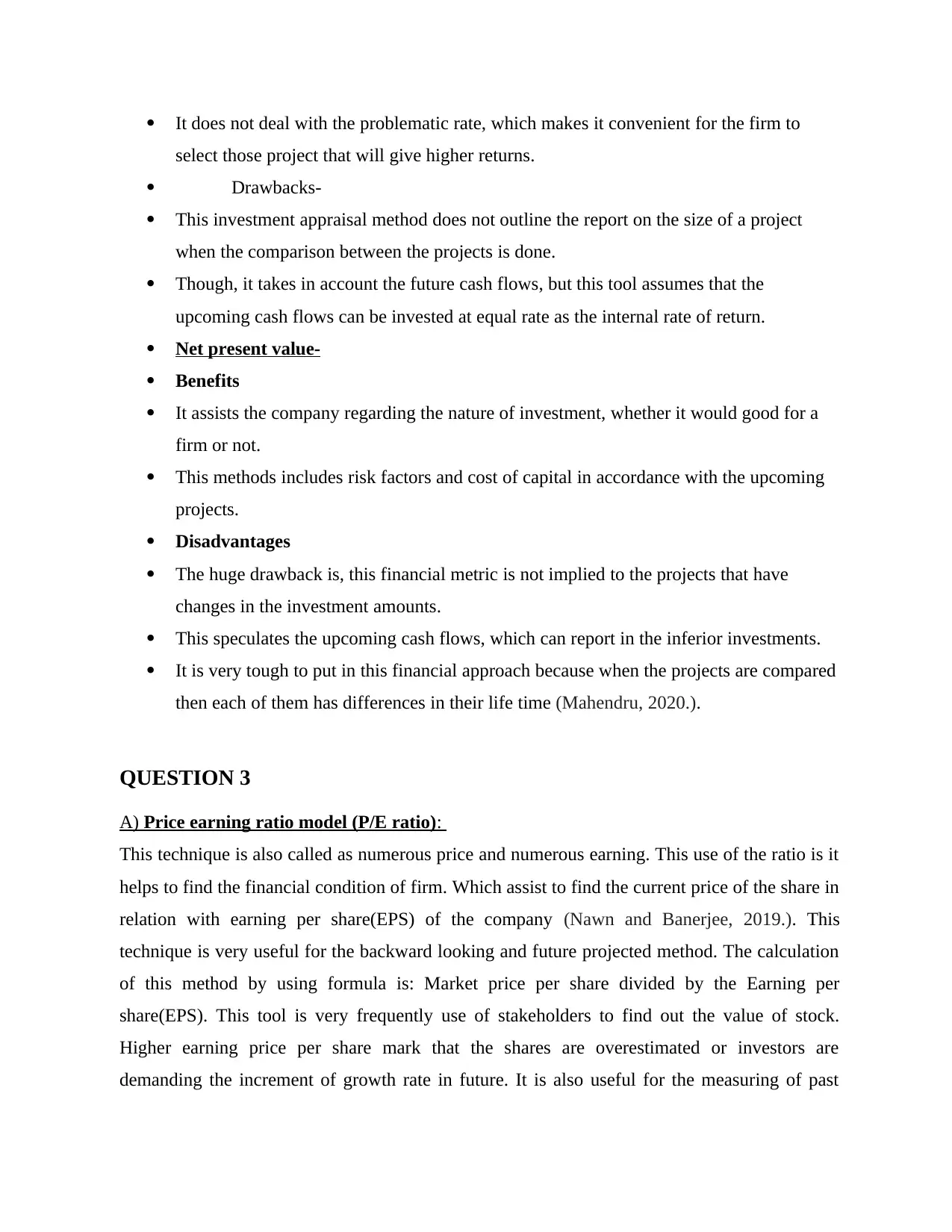
It does not deal with the problematic rate, which makes it convenient for the firm to
select those project that will give higher returns.
Drawbacks-
This investment appraisal method does not outline the report on the size of a project
when the comparison between the projects is done.
Though, it takes in account the future cash flows, but this tool assumes that the
upcoming cash flows can be invested at equal rate as the internal rate of return.
Net present value-
Benefits
It assists the company regarding the nature of investment, whether it would good for a
firm or not.
This methods includes risk factors and cost of capital in accordance with the upcoming
projects.
Disadvantages
The huge drawback is, this financial metric is not implied to the projects that have
changes in the investment amounts.
This speculates the upcoming cash flows, which can report in the inferior investments.
It is very tough to put in this financial approach because when the projects are compared
then each of them has differences in their life time (Mahendru, 2020.).
QUESTION 3
A) Price earning ratio model (P/E ratio):
This technique is also called as numerous price and numerous earning. This use of the ratio is it
helps to find the financial condition of firm. Which assist to find the current price of the share in
relation with earning per share(EPS) of the company (Nawn and Banerjee, 2019.). This
technique is very useful for the backward looking and future projected method. The calculation
of this method by using formula is: Market price per share divided by the Earning per
share(EPS). This tool is very frequently use of stakeholders to find out the value of stock.
Higher earning price per share mark that the shares are overestimated or investors are
demanding the increment of growth rate in future. It is also useful for the measuring of past
select those project that will give higher returns.
Drawbacks-
This investment appraisal method does not outline the report on the size of a project
when the comparison between the projects is done.
Though, it takes in account the future cash flows, but this tool assumes that the
upcoming cash flows can be invested at equal rate as the internal rate of return.
Net present value-
Benefits
It assists the company regarding the nature of investment, whether it would good for a
firm or not.
This methods includes risk factors and cost of capital in accordance with the upcoming
projects.
Disadvantages
The huge drawback is, this financial metric is not implied to the projects that have
changes in the investment amounts.
This speculates the upcoming cash flows, which can report in the inferior investments.
It is very tough to put in this financial approach because when the projects are compared
then each of them has differences in their life time (Mahendru, 2020.).
QUESTION 3
A) Price earning ratio model (P/E ratio):
This technique is also called as numerous price and numerous earning. This use of the ratio is it
helps to find the financial condition of firm. Which assist to find the current price of the share in
relation with earning per share(EPS) of the company (Nawn and Banerjee, 2019.). This
technique is very useful for the backward looking and future projected method. The calculation
of this method by using formula is: Market price per share divided by the Earning per
share(EPS). This tool is very frequently use of stakeholders to find out the value of stock.
Higher earning price per share mark that the shares are overestimated or investors are
demanding the increment of growth rate in future. It is also useful for the measuring of past
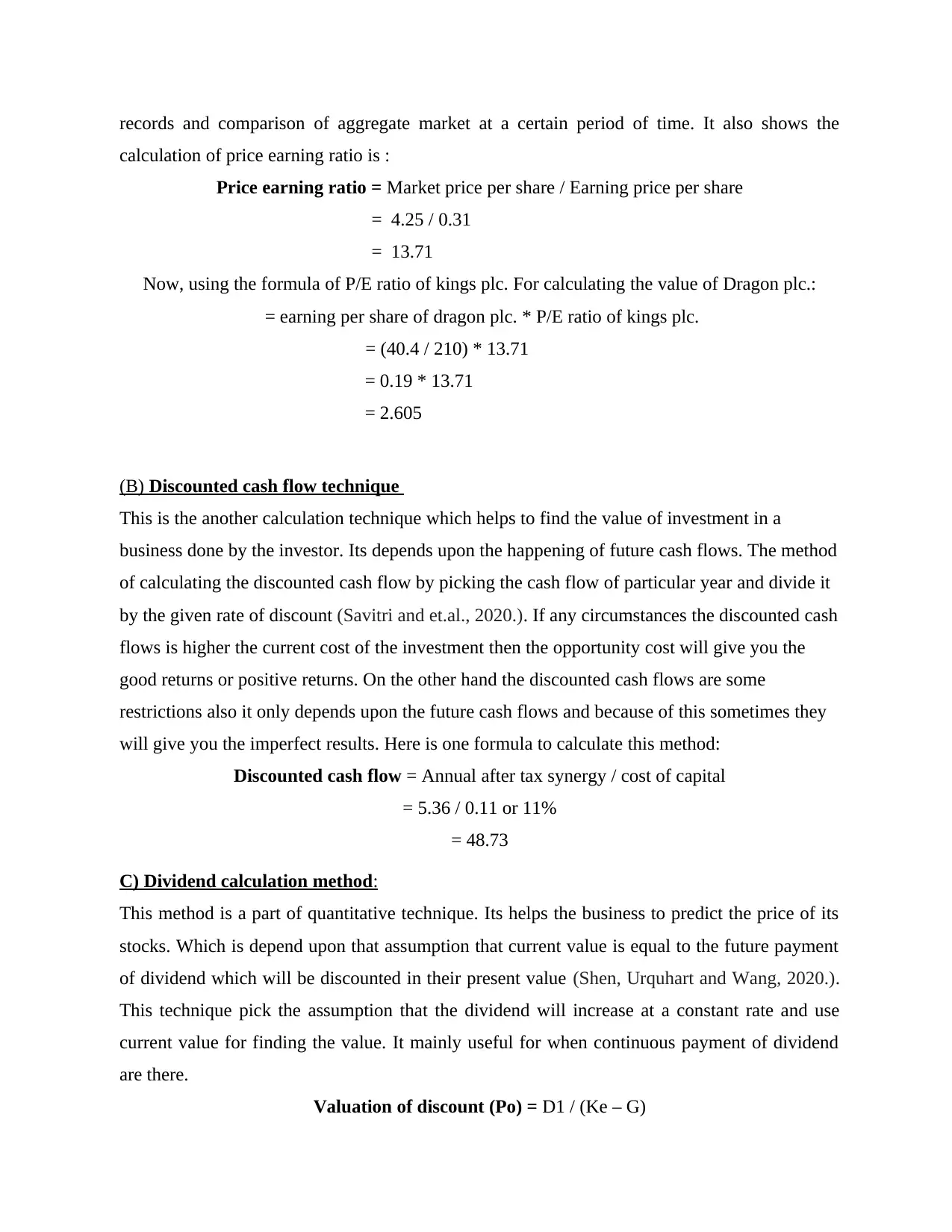
records and comparison of aggregate market at a certain period of time. It also shows the
calculation of price earning ratio is :
Price earning ratio = Market price per share / Earning price per share
= 4.25 / 0.31
= 13.71
Now, using the formula of P/E ratio of kings plc. For calculating the value of Dragon plc.:
= earning per share of dragon plc. * P/E ratio of kings plc.
= (40.4 / 210) * 13.71
= 0.19 * 13.71
= 2.605
(B) Discounted cash flow technique
This is the another calculation technique which helps to find the value of investment in a
business done by the investor. Its depends upon the happening of future cash flows. The method
of calculating the discounted cash flow by picking the cash flow of particular year and divide it
by the given rate of discount (Savitri and et.al., 2020.). If any circumstances the discounted cash
flows is higher the current cost of the investment then the opportunity cost will give you the
good returns or positive returns. On the other hand the discounted cash flows are some
restrictions also it only depends upon the future cash flows and because of this sometimes they
will give you the imperfect results. Here is one formula to calculate this method:
Discounted cash flow = Annual after tax synergy / cost of capital
= 5.36 / 0.11 or 11%
= 48.73
C) Dividend calculation method:
This method is a part of quantitative technique. Its helps the business to predict the price of its
stocks. Which is depend upon that assumption that current value is equal to the future payment
of dividend which will be discounted in their present value (Shen, Urquhart and Wang, 2020.).
This technique pick the assumption that the dividend will increase at a constant rate and use
current value for finding the value. It mainly useful for when continuous payment of dividend
are there.
Valuation of discount (Po) = D1 / (Ke – G)
calculation of price earning ratio is :
Price earning ratio = Market price per share / Earning price per share
= 4.25 / 0.31
= 13.71
Now, using the formula of P/E ratio of kings plc. For calculating the value of Dragon plc.:
= earning per share of dragon plc. * P/E ratio of kings plc.
= (40.4 / 210) * 13.71
= 0.19 * 13.71
= 2.605
(B) Discounted cash flow technique
This is the another calculation technique which helps to find the value of investment in a
business done by the investor. Its depends upon the happening of future cash flows. The method
of calculating the discounted cash flow by picking the cash flow of particular year and divide it
by the given rate of discount (Savitri and et.al., 2020.). If any circumstances the discounted cash
flows is higher the current cost of the investment then the opportunity cost will give you the
good returns or positive returns. On the other hand the discounted cash flows are some
restrictions also it only depends upon the future cash flows and because of this sometimes they
will give you the imperfect results. Here is one formula to calculate this method:
Discounted cash flow = Annual after tax synergy / cost of capital
= 5.36 / 0.11 or 11%
= 48.73
C) Dividend calculation method:
This method is a part of quantitative technique. Its helps the business to predict the price of its
stocks. Which is depend upon that assumption that current value is equal to the future payment
of dividend which will be discounted in their present value (Shen, Urquhart and Wang, 2020.).
This technique pick the assumption that the dividend will increase at a constant rate and use
current value for finding the value. It mainly useful for when continuous payment of dividend
are there.
Valuation of discount (Po) = D1 / (Ke – G)
⊘ This is a preview!⊘
Do you want full access?
Subscribe today to unlock all pages.

Trusted by 1+ million students worldwide
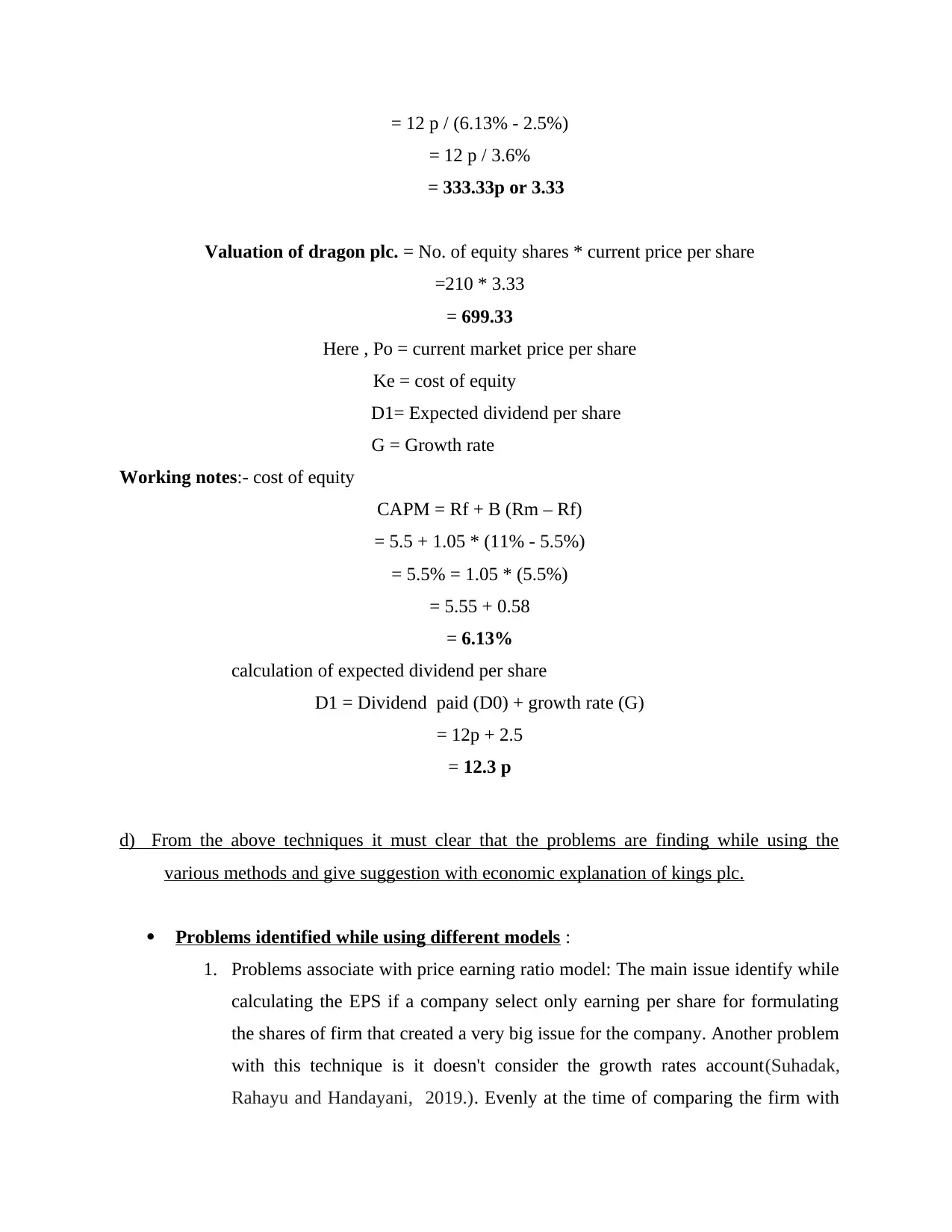
= 12 p / (6.13% - 2.5%)
= 12 p / 3.6%
= 333.33p or 3.33
Valuation of dragon plc. = No. of equity shares * current price per share
=210 * 3.33
= 699.33
Here , Po = current market price per share
Ke = cost of equity
D1= Expected dividend per share
G = Growth rate
Working notes:- cost of equity
CAPM = Rf + B (Rm – Rf)
= 5.5 + 1.05 * (11% - 5.5%)
= 5.5% = 1.05 * (5.5%)
= 5.55 + 0.58
= 6.13%
calculation of expected dividend per share
D1 = Dividend paid (D0) + growth rate (G)
= 12p + 2.5
= 12.3 p
d) From the above techniques it must clear that the problems are finding while using the
various methods and give suggestion with economic explanation of kings plc.
Problems identified while using different models :
1. Problems associate with price earning ratio model: The main issue identify while
calculating the EPS if a company select only earning per share for formulating
the shares of firm that created a very big issue for the company. Another problem
with this technique is it doesn't consider the growth rates account(Suhadak,
Rahayu and Handayani, 2019.). Evenly at the time of comparing the firm with
= 12 p / 3.6%
= 333.33p or 3.33
Valuation of dragon plc. = No. of equity shares * current price per share
=210 * 3.33
= 699.33
Here , Po = current market price per share
Ke = cost of equity
D1= Expected dividend per share
G = Growth rate
Working notes:- cost of equity
CAPM = Rf + B (Rm – Rf)
= 5.5 + 1.05 * (11% - 5.5%)
= 5.5% = 1.05 * (5.5%)
= 5.55 + 0.58
= 6.13%
calculation of expected dividend per share
D1 = Dividend paid (D0) + growth rate (G)
= 12p + 2.5
= 12.3 p
d) From the above techniques it must clear that the problems are finding while using the
various methods and give suggestion with economic explanation of kings plc.
Problems identified while using different models :
1. Problems associate with price earning ratio model: The main issue identify while
calculating the EPS if a company select only earning per share for formulating
the shares of firm that created a very big issue for the company. Another problem
with this technique is it doesn't consider the growth rates account(Suhadak,
Rahayu and Handayani, 2019.). Evenly at the time of comparing the firm with
Paraphrase This Document
Need a fresh take? Get an instant paraphrase of this document with our AI Paraphraser
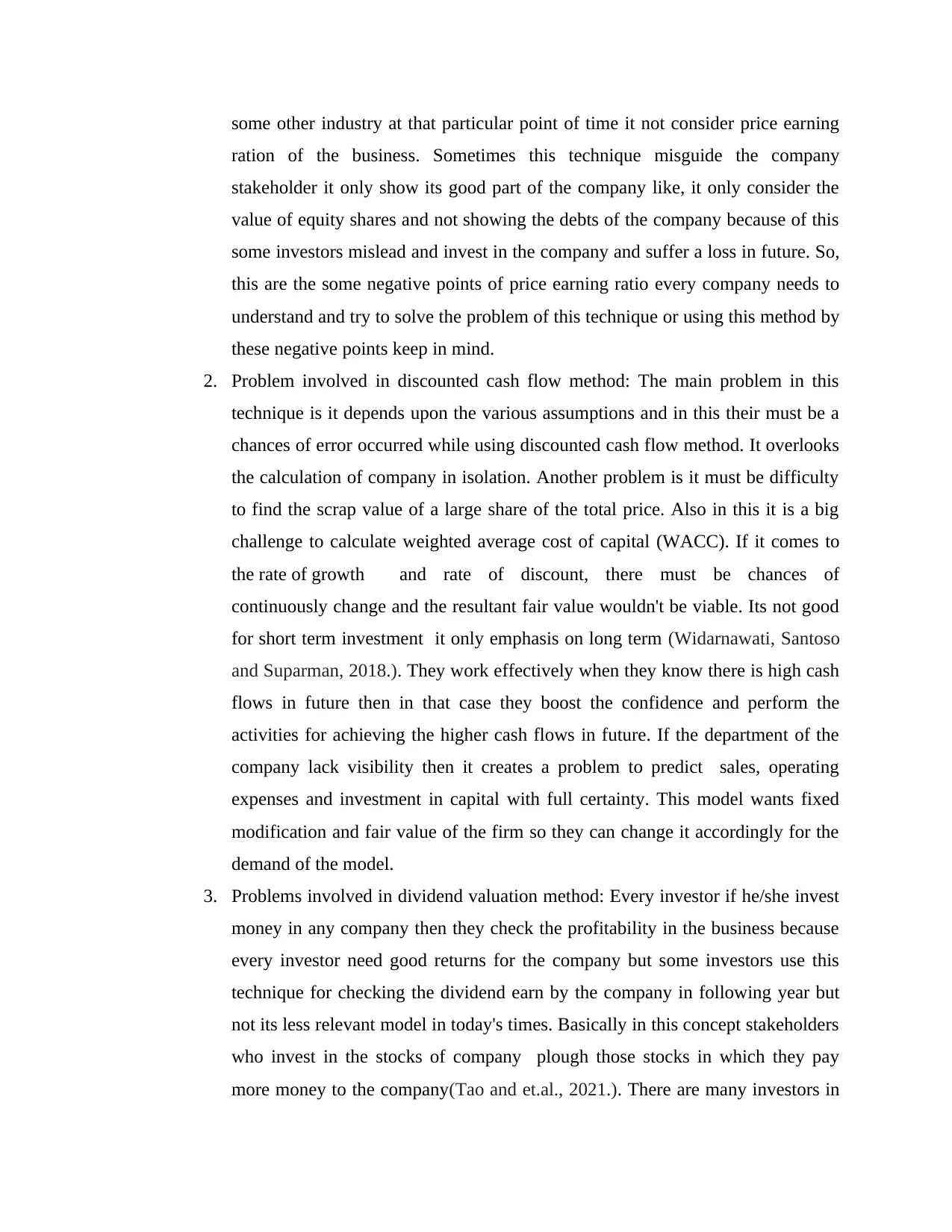
some other industry at that particular point of time it not consider price earning
ration of the business. Sometimes this technique misguide the company
stakeholder it only show its good part of the company like, it only consider the
value of equity shares and not showing the debts of the company because of this
some investors mislead and invest in the company and suffer a loss in future. So,
this are the some negative points of price earning ratio every company needs to
understand and try to solve the problem of this technique or using this method by
these negative points keep in mind.
2. Problem involved in discounted cash flow method: The main problem in this
technique is it depends upon the various assumptions and in this their must be a
chances of error occurred while using discounted cash flow method. It overlooks
the calculation of company in isolation. Another problem is it must be difficulty
to find the scrap value of a large share of the total price. Also in this it is a big
challenge to calculate weighted average cost of capital (WACC). If it comes to
the rate of growth and rate of discount, there must be chances of
continuously change and the resultant fair value wouldn't be viable. Its not good
for short term investment it only emphasis on long term (Widarnawati, Santoso
and Suparman, 2018.). They work effectively when they know there is high cash
flows in future then in that case they boost the confidence and perform the
activities for achieving the higher cash flows in future. If the department of the
company lack visibility then it creates a problem to predict sales, operating
expenses and investment in capital with full certainty. This model wants fixed
modification and fair value of the firm so they can change it accordingly for the
demand of the model.
3. Problems involved in dividend valuation method: Every investor if he/she invest
money in any company then they check the profitability in the business because
every investor need good returns for the company but some investors use this
technique for checking the dividend earn by the company in following year but
not its less relevant model in today's times. Basically in this concept stakeholders
who invest in the stocks of company plough those stocks in which they pay
more money to the company(Tao and et.al., 2021.). There are many investors in
ration of the business. Sometimes this technique misguide the company
stakeholder it only show its good part of the company like, it only consider the
value of equity shares and not showing the debts of the company because of this
some investors mislead and invest in the company and suffer a loss in future. So,
this are the some negative points of price earning ratio every company needs to
understand and try to solve the problem of this technique or using this method by
these negative points keep in mind.
2. Problem involved in discounted cash flow method: The main problem in this
technique is it depends upon the various assumptions and in this their must be a
chances of error occurred while using discounted cash flow method. It overlooks
the calculation of company in isolation. Another problem is it must be difficulty
to find the scrap value of a large share of the total price. Also in this it is a big
challenge to calculate weighted average cost of capital (WACC). If it comes to
the rate of growth and rate of discount, there must be chances of
continuously change and the resultant fair value wouldn't be viable. Its not good
for short term investment it only emphasis on long term (Widarnawati, Santoso
and Suparman, 2018.). They work effectively when they know there is high cash
flows in future then in that case they boost the confidence and perform the
activities for achieving the higher cash flows in future. If the department of the
company lack visibility then it creates a problem to predict sales, operating
expenses and investment in capital with full certainty. This model wants fixed
modification and fair value of the firm so they can change it accordingly for the
demand of the model.
3. Problems involved in dividend valuation method: Every investor if he/she invest
money in any company then they check the profitability in the business because
every investor need good returns for the company but some investors use this
technique for checking the dividend earn by the company in following year but
not its less relevant model in today's times. Basically in this concept stakeholders
who invest in the stocks of company plough those stocks in which they pay
more money to the company(Tao and et.al., 2021.). There are many investors in
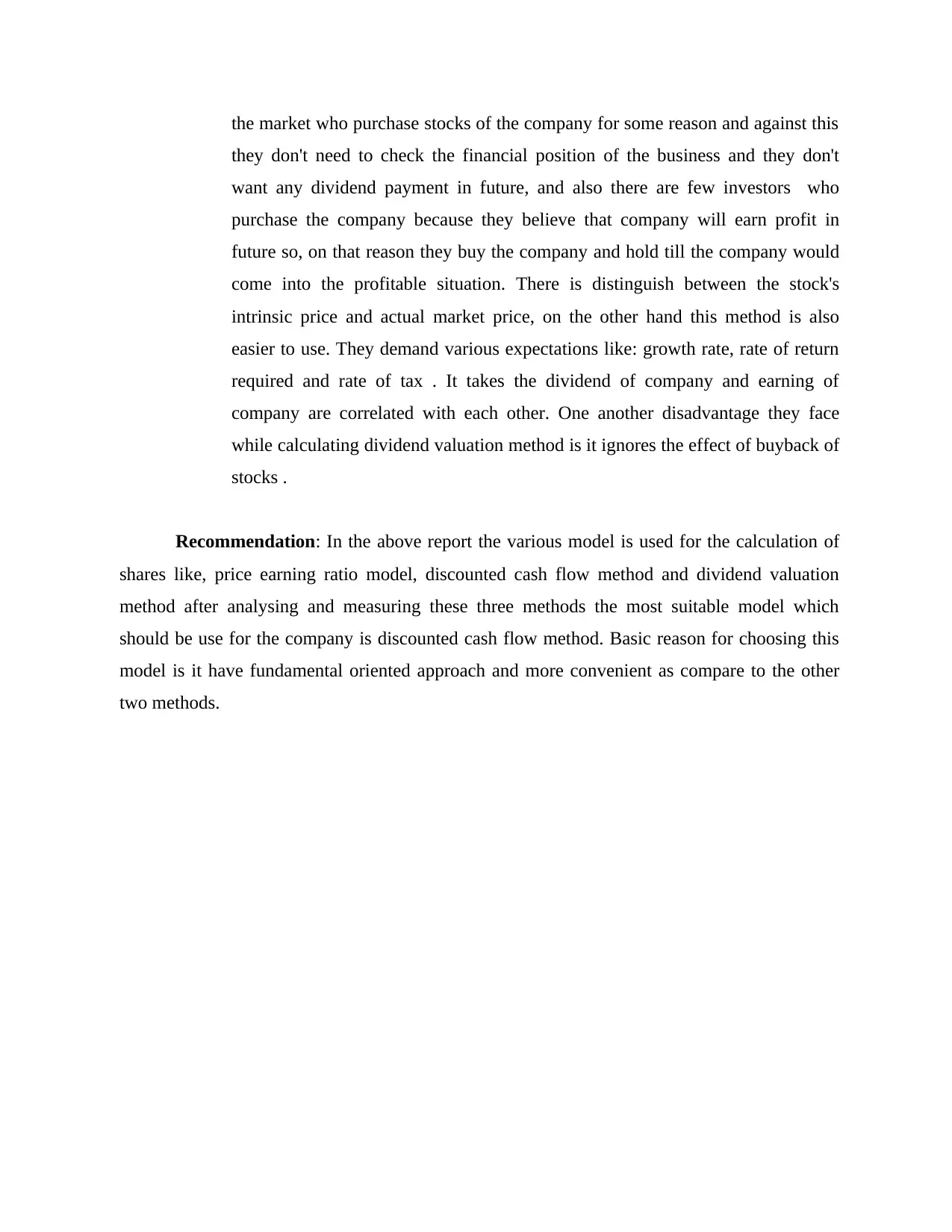
the market who purchase stocks of the company for some reason and against this
they don't need to check the financial position of the business and they don't
want any dividend payment in future, and also there are few investors who
purchase the company because they believe that company will earn profit in
future so, on that reason they buy the company and hold till the company would
come into the profitable situation. There is distinguish between the stock's
intrinsic price and actual market price, on the other hand this method is also
easier to use. They demand various expectations like: growth rate, rate of return
required and rate of tax . It takes the dividend of company and earning of
company are correlated with each other. One another disadvantage they face
while calculating dividend valuation method is it ignores the effect of buyback of
stocks .
Recommendation: In the above report the various model is used for the calculation of
shares like, price earning ratio model, discounted cash flow method and dividend valuation
method after analysing and measuring these three methods the most suitable model which
should be use for the company is discounted cash flow method. Basic reason for choosing this
model is it have fundamental oriented approach and more convenient as compare to the other
two methods.
they don't need to check the financial position of the business and they don't
want any dividend payment in future, and also there are few investors who
purchase the company because they believe that company will earn profit in
future so, on that reason they buy the company and hold till the company would
come into the profitable situation. There is distinguish between the stock's
intrinsic price and actual market price, on the other hand this method is also
easier to use. They demand various expectations like: growth rate, rate of return
required and rate of tax . It takes the dividend of company and earning of
company are correlated with each other. One another disadvantage they face
while calculating dividend valuation method is it ignores the effect of buyback of
stocks .
Recommendation: In the above report the various model is used for the calculation of
shares like, price earning ratio model, discounted cash flow method and dividend valuation
method after analysing and measuring these three methods the most suitable model which
should be use for the company is discounted cash flow method. Basic reason for choosing this
model is it have fundamental oriented approach and more convenient as compare to the other
two methods.
⊘ This is a preview!⊘
Do you want full access?
Subscribe today to unlock all pages.

Trusted by 1+ million students worldwide
1 out of 14
Related Documents
Your All-in-One AI-Powered Toolkit for Academic Success.
+13062052269
info@desklib.com
Available 24*7 on WhatsApp / Email
![[object Object]](/_next/static/media/star-bottom.7253800d.svg)
Unlock your academic potential
Copyright © 2020–2025 A2Z Services. All Rights Reserved. Developed and managed by ZUCOL.





